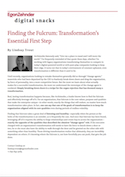Finding the Fulcrum: Transformation’s Essential First Step
Archimedes famously said, “Give me a place to stand and I will move the world.” I’m frequently reminded of that quote these days, whether I’m working with legacy organizations transforming themselves to compete in today’s digital-powered world or with pure-play companies looking to keep their edge. It turns out that in today’s environment of constant upheaval, even transformation is different than it used to be.
Until recently, organizations looking to remake themselves generally did so through “change agents,” mavericks who had been deputized by the CEO to fearlessly break down doors and drag the organization, by force of personality, into a more competitive future. But the more we learn about what actually makes for a successful transformation, the more we understand the stereotype of the change agent is outdated. Simply breaking down doors is a recipe for the organ rejection that has doomed many a transformation.
Real, lasting transformation happens because, like Archimedes, a leader knows how to find the fulcrum and effectively leverage off of it. For an organization, that fulcrum is the core values, purpose and qualities that make the enterprise unique—in other words, exactly the things that will endure, no matter how much transformation takes place. In fact, one can say that one of the goals of transformation is to keep the organization aligned with its core qualities even during periods of endless volatility.
Finding that fulcrum takes a great deal of listening and humility—especially when the person at the helm of the transformation is an outsider, as is frequently the case. And once that fulcrum has been found, leveraging off of it requires the ability to forge relationships and create buy-in across the organization— exactly the opposite of the qualities that described the obsolete “change agent” role. If the executive charged with an organization’s transformation still needs to have the force to knock down a door or two, he or she must also have the ability to walk through the door and be greeted on the other side with something other than hostility. Those driving transformation realize that ultimately, they are incredibly dependent on others. It’s knowing where the fulcrum is, not how forcefully you can push, that gets the job done.
Contact Lindsay at:
lindsay.trout@egonzehnder.com
+1 650 847 3065







